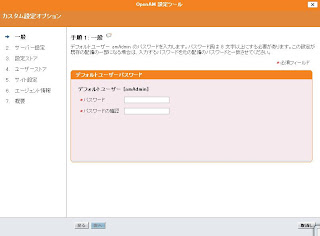サンプルアプリ(Consumer)とTwitter(Service Provider)をOAuth1.0で連携させ、Twitterのつぶやきをアプリで表示してみる。
①gemコマンドを使用し、oauthをインストールする。
c:\>gem install oauth
Fetching: oauth-0.4.5.gem (100%)
Successfully installed oauth-0.4.5
1 gem installed
Installing ri documentation for oauth-0.4.5...
Installing RDoc documentation for oauth-0.4.5...
②Twitterの以下のOAuthページにサンプルアプリケーション(Consumer)を登録する。登録した後、Consumer keyとConsumer sercretが作成される。
https://dev.twitter.com/apps
③Railsアプリケーションを作成する。
C:\Users\yasu\clientapp>rails new twitoauth
create
create README
create Rakefile
create config.ru
create .gitignore
create Gemfile
create app
create app/assets/images/rails.png
create app/assets/javascripts/application.js
create app/assets/stylesheets/application.css
create app/controllers/application_controller.rb
create app/helpers/application_helper.rb
create app/mailers
create app/models
create app/views/layouts/application.html.erb
create app/mailers/.gitkeep
create app/models/.gitkeep
create config
create config/routes.rb
create config/application.rb
create config/environment.rb
create config/environments
create config/environments/development.rb
create config/environments/production.rb
create config/environments/test.rb
create config/initializers
create config/initializers/backtrace_silencers.rb
create config/initializers/inflections.rb
create config/initializers/mime_types.rb
create config/initializers/secret_token.rb
create config/initializers/session_store.rb
create config/initializers/wrap_parameters.rb
create config/locales
create config/locales/en.yml
create config/boot.rb
create config/database.yml
create db
create db/seeds.rb
create doc
create doc/README_FOR_APP
create lib
create lib/tasks
create lib/tasks/.gitkeep
create lib/assets
create lib/assets/.gitkeep
create log
create log/.gitkeep
create public
create public/404.html
create public/422.html
create public/500.html
create public/favicon.ico
create public/index.html
create public/robots.txt
create script
create script/rails
create test/fixtures
create test/fixtures/.gitkeep
create test/functional
create test/functional/.gitkeep
create test/integration
create test/integration/.gitkeep
create test/unit
create test/unit/.gitkeep
create test/performance/browsing_test.rb
create test/test_helper.rb
create tmp/cache
create tmp/cache/assets
create vendor/assets/stylesheets
create vendor/assets/stylesheets/.gitkeep
create vendor/plugins
create vendor/plugins/.gitkeep
run bundle install
Fetching source index for http://rubygems.org/
Installing rake (0.9.2.2)
Installing multi_json (1.0.4)
Using activesupport (3.1.2)
Using builder (3.0.0)
Using i18n (0.6.0)
Using activemodel (3.1.2)
Using erubis (2.7.0)
Using rack (1.3.5)
Using rack-cache (1.1)
Using rack-mount (0.8.3)
Using rack-test (0.6.1)
Using hike (1.2.1)
Using tilt (1.3.3)
Installing sprockets (2.1.2)
Using actionpack (3.1.2)
Using mime-types (1.17.2)
Using polyglot (0.3.3)
Using treetop (1.4.10)
Using mail (2.3.0)
Using actionmailer (3.1.2)
Using arel (2.2.1)
Using tzinfo (0.3.31)
Using activerecord (3.1.2)
Using activeresource (3.1.2)
Installing ansi (1.4.1)
Using bundler (1.0.21)
Installing coffee-script-source (1.1.3)
Installing execjs (1.2.9)
Installing coffee-script (2.2.0)
Using rack-ssl (1.3.2)
Installing json (1.6.3) with native extensions
Using rdoc (3.11)
Using thor (0.14.6)
Using railties (3.1.2)
Installing coffee-rails (3.1.1)
Installing jquery-rails (1.0.19)
Using rails (3.1.2)
Installing sass (3.1.11)
Installing sass-rails (3.1.5)
Using sqlite3 (1.3.4)
Installing turn (0.8.3)
Installing uglifier (1.1.0)
Your bundle is complete! Use `bundle show [gemname]` to see where a bundled gem
is installed.
C:\Users\yasu\clientapp>cd twitoauth
C:\Users\yasu\clientapp\twitoauth>rails generate controller index
create app/controllers/index_controller.rb
invoke erb
create app/views/index
invoke test_unit
create test/functional/index_controller_test.rb
invoke helper
create app/helpers/index_helper.rb
invoke test_unit
create test/unit/helpers/index_helper_test.rb
invoke assets
invoke coffee
create app/assets/javascripts/index.js.coffee
invoke scss
create app/assets/stylesheets/index.css.scss
④C:\Users\yasu\clientapp\twitoauth\app\controllers\IndexController.rbを修正し、IndexContollerクラスを作成する。
--------------------------------------------------------
require 'json'
require "oauth"
class IndexController < ApplicationController
def self.consumer
OAuth::Consumer.new(
"Consumer key", ←★Twitter画面で表示されたConsumer Keyを設定。
"Consumer secret", ←★Twitter画面で表示されたConsumer secretを設定。
{ :site => "http://twitter.com" }
)
end
def index
end
def oauth
# 未認可のRequestTokenの取得
request_token = IndexController.consumer.get_request_token(
:oauth_callback => "http://#{request.host_with_port}/oauth_callback"
)
session[:request_token] = request_token.token
session[:request_token_secret] = request_token.secret
# RequestTokenの認可要求
redirect_to request_token.authorize_url
return
end
def oauth_callback
consumer = IndexController.consumer
# 認可済みRequestTokenの取得
request_token = OAuth::RequestToken.new(
consumer,
session[:request_token],
session[:request_token_secret]
)
# AccessTokenの取得
access_token = request_token.get_access_token(
{},
:oauth_token => params[:oauth_token],
:oauth_verifier => params[:oauth_verifier]
)
# AccessTokenをもとに、ServiceProviderサービスを呼び出す
response = consumer.request(
:get,
'/account/verify_credentials.json',
access_token, { :scheme => :query_string }
)
case response
when Net::HTTPSuccess
@user_info = JSON.parse(response.body)
unless @user_info['screen_name']
flash[:notice] = "Authentication failed"
redirect_to :action => :index
return
end
else
RAILS_DEFAULT_LOGGER.error "Failed to get user info via OAuth"
flash[:notice] = "Authentication failed"
redirect_to :action => :index
return
end
end
end
----------------------------------------
⑤indexアクションに対応するviewを作成する(C:\Users\yasu\clientapp\twitoauth\app\views\index\index.erbを作成
)。
<html>
<head>
<meta http-equiv="content-type" content="text/html; charset=utf-8" />
<title>OAuth Sample App</title>
</head>
<body>
<a href="/oauth">Authentication at Twitter</a>
</body>
</html>
⑥indexアクションとURLをマッピングする。C:\Users\yasu\clientapp\twitoauth\config\routes.rbに以下を追加する。
----------------------------------
get "oauthclient" => "index#index"
get "oauth" => "index"
get "oauth_callback" => "index"
----------------------------------
c:\Users\yasu\clientapp\twitoauth>rake routes
oauthclient GET /oauthclient(.:format) {:action=>"index", :controller=>"index"}
oauth GET /oauth(.:format) {:action=>"oauth", :controller=>"index"}
oauth_callback GET /oauth_callback(.:format) {:action=>"oauth_callback", :controller=>"index"}
⑦Service Provider(Twitter)からAccess Tokenを取得した後のConsumerの戻り先erbを作成する。
(C:\Users\yasu\clientapp\twitoauth\app\views\index\oauth_callback.erb)
<html>
<head>
<meta http-equiv="content-type" content="text/html; charset=utf-8" />
<title>Access succeed!</title>
</head>
<body>
<h1><%= @user_info['name'] %> 's tubuyaki</h1>
<%= @user_info['status']['text'] %>
</body>
</html>
⑧WEBrickを起動する。
C:\Users\yasu\clientapp\twitoauth>rails server -p 3001
=> Booting WEBrick
=> Rails 3.1.2 application starting in development on http://0.0.0.0:3001
=> Call with -d to detach
=> Ctrl-C to shutdown server
[2011-12-02 23:58:49] INFO WEBrick 1.3.1
[2011-12-02 23:58:52] INFO ruby 1.9.3 (2011-10-30) [i386-mingw32]
[2011-12-02 23:58:52] INFO WEBrick::HTTPServer#start: pid=8656 port=3001
⑨「
http://openam.yasuyasu.com:3001/oauthclient」にアクセスし、以下の画面が表示されることを確認する。
また、「連携アプリを認証」ボタンを押下した後、最新のつぶやきが表示されることを確認する。




















